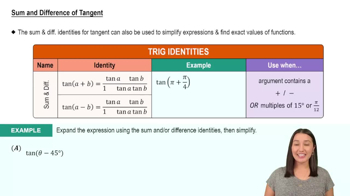Textbook Question
In Exercises 45–46, find the area of the triangle with the given vertices. Round to the nearest square unit.(-2, -3), (-2, 2), (2, 1)
433
views

 Verified step by step guidance
Verified step by step guidance Verified video answer for a similar problem:
Verified video answer for a similar problem:



 4:27m
4:27mMaster Intro to Law of Sines with a bite sized video explanation from Patrick
Start learning